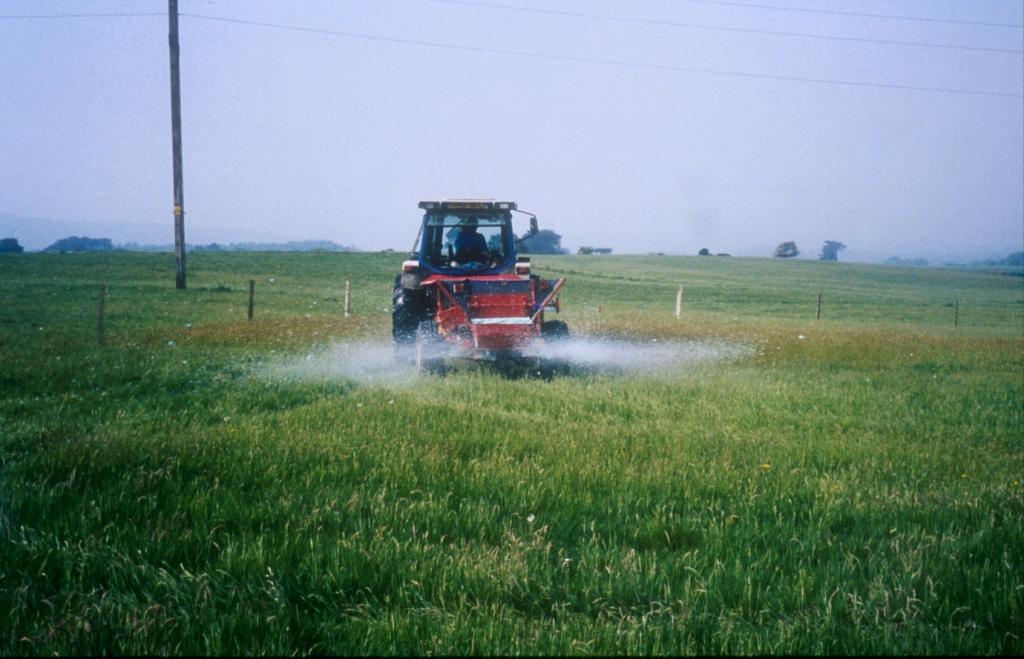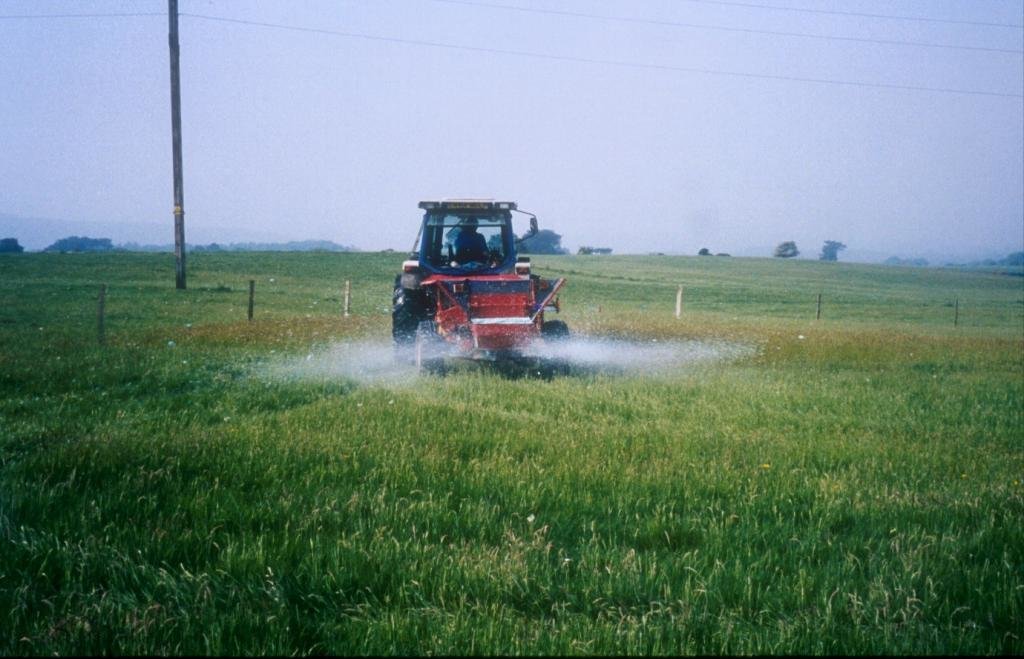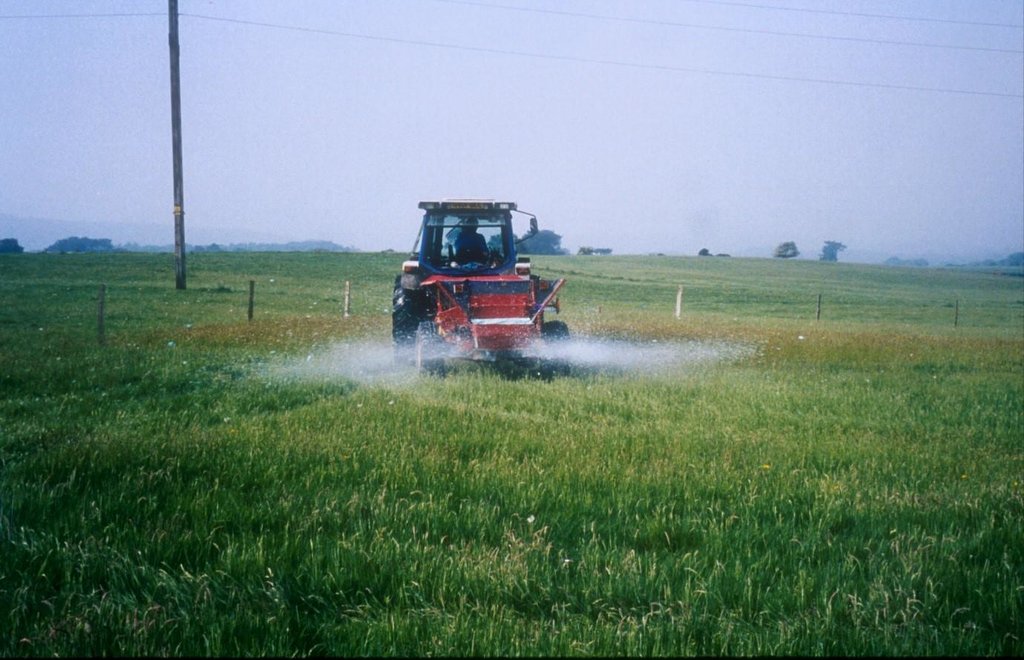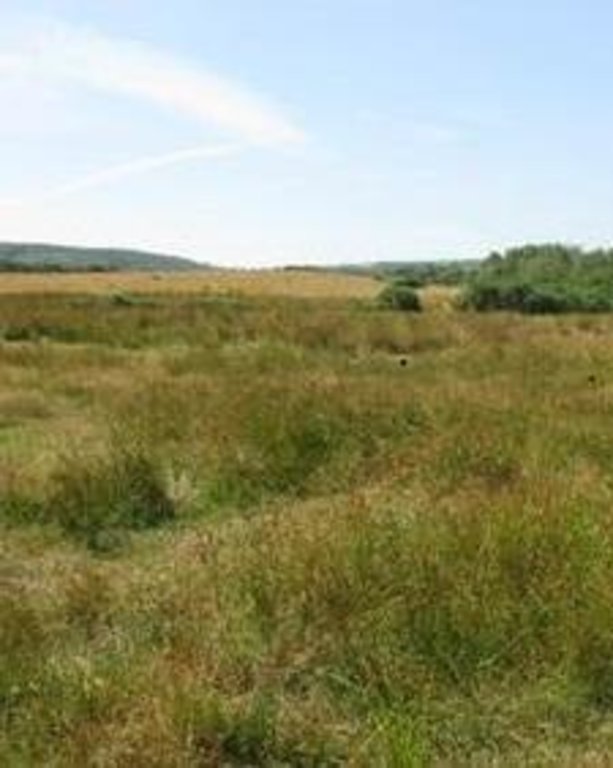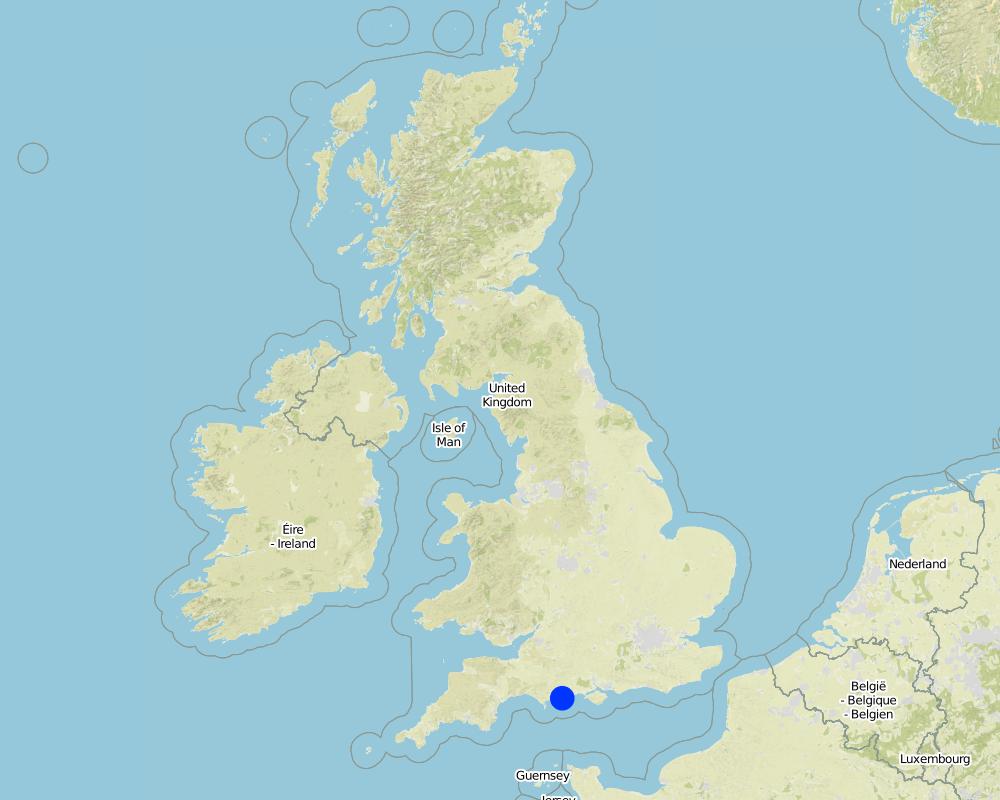Soil pH management [United Kingdom]
- Creation:
- Update:
- Compiler: Tandra Fraser
- Editor: –
- Reviewer: Fabian Ottiger
approaches_2615 - United Kingdom
View sections
Expand all Collapse all1. General information
1.2 Contact details of resource persons and institutions involved in the assessment and documentation of the Approach
SLM specialist:
Tibbett Mark
m.tibbett@reading.ac.uk
University of Reading
Reading RG6 6UA
United Kingdom
Name of the institution(s) which facilitated the documentation/ evaluation of the Approach (if relevant)
University of Reading (University of Reading) - United Kingdom1.3 Conditions regarding the use of data documented through WOCAT
When were the data compiled (in the field)?
03/05/2016
The compiler and key resource person(s) accept the conditions regarding the use of data documented through WOCAT:
Ja
1.4 Reference(s) to Questionnaire(s) on SLM Technologies
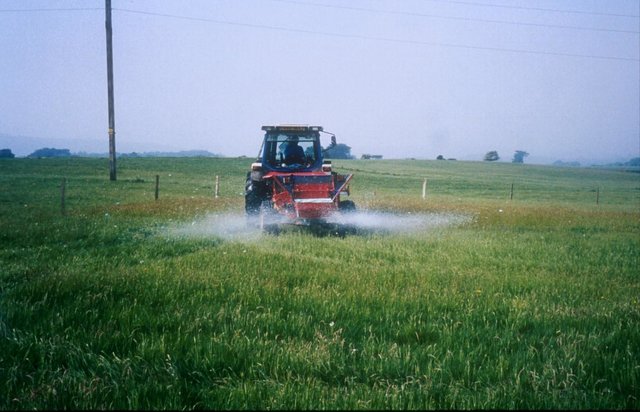
Soil pH management [United Kingdom]
Acidification treatments were applied to improved pastures in an attempt to restore plots to a semi-natural state
- Compiler: Tandra Fraser
2. Description of the SLM Approach
2.1 Short description of the Approach
Acidification treatments were applied to improved pastures in an attempt to restore plots to low-intensity grazing land
2.2 Detailed description of the Approach
Detailed description of the Approach:
Aims / objectives: To convert the area from intensive pastureland to a semi-natural state with low intensity grazing through alteration of the soil pH. This change in land-use should have a positive effect on both above- and belowground biodiversity.
Methods: Plots were established on two adjacent farms owned by National Trust near Wareham, Dorset (Newlines Farm and Hartland Farm). A control and two sulphur amendments were compared on plots on ten fields (five from each farm) on 50 m x 50 m plots. Elemental sulphur (Brimestone 90TM) or ferrous sulphate (Mistrale “Wet Copperas” 50TM) were applied at equal rates of 2000 kg ha-1 in May 2000 and a second application of 1600 kg ha-1 in March 2001.
Stages of implementation: Treatments were applied in 2000 and 2001. Periodic monitoring has been conducted to monitor changes in plant diversity and soil chemical and biological properties.
Role of stakeholders: Stakesholders played an active role in identifying management options and implementing the technology. When the original plots were established, a charitable organisation was the primary stakeholder. For the intent of the current project, other stakeholders became involved, including parish council, landowners, and conservation organisations.
Other important information: Acidification treatments were applied to plots on the Isle of Purbeck that had previously been used for arable production and then high intensity grazing. The site is located on acidic fluvially-deposited soil and was in lowland heath until the middle of the 20th century at which time the land was tilled and treatments of rock phosphate, marl and chalk were added to increase soil pH and nutrient availability and improve the potential of the land for agricultural production.
2.3 Photos of the Approach
2.5 Country/ region/ locations where the Approach has been applied
Country:
United Kingdom
Region/ State/ Province:
Dorset
Further specification of location:
Wareham
Map
×2.6 Dates of initiation and termination of the Approach
Indicate year of initiation:
1999
2.7 Type of Approach
- project/ programme based
2.8 Main aims/ objectives of the Approach
The Approach focused mainly on other activities than SLM (soil, pH, below-ground biodiversity, low-intensity grazing)
To manage soil pH change and associated effects on above and below-ground diversity and function
The SLM Approach addressed the following problems: Management of soil pH and land use change to less intensive system
2.9 Conditions enabling or hindering implementation of the Technology/ Technologies applied under the Approach
social/ cultural/ religious norms and values
- hindering
Local confusion about land use change
Treatment through the SLM Approach: Public workshop explained reasons to stakeholders
availability/ access to financial resources and services
- hindering
Loss of earning as less intensive system is less productive
Treatment through the SLM Approach: Ecological benefits balance against economic losses
legal framework (land tenure, land and water use rights)
- enabling
The existing land ownership, land use rights / water rights greatly helped the approach implementation: The land where the approach was implement was managed by National Trust UK who had a special interest in reclamation and conservation.
3. Participation and roles of stakeholders involved
3.1 Stakeholders involved in the Approach and their roles
- local land users/ local communities
- SLM specialists/ agricultural advisers
- NGO
- international organization
3.2 Involvement of local land users/ local communities in the different phases of the Approach
| Involvement of local land users/ local communities | Specify who was involved and describe activities | |
|---|---|---|
| initiation/ motivation | external support | Land owners who acquired national support |
| planning | external support | By specialist |
| implementation | interactive | By land owner and specialist |
| monitoring/ evaluation | external support | By Specialist |
| Research | external support | By specialist |
3.4 Decision-making on the selection of SLM Technology/ Technologies
Specify who decided on the selection of the Technology/ Technologies to be implemented:
- mainly SLM specialists, following consultation with land users
Explain:
Decisions on the method of implementing the SLM Technology were made by mainly by land users supported by SLM specialists
4. Technical support, capacity building, and knowledge management
4.1 Capacity building/ training
Was training provided to land users/ other stakeholders?
Ja
Specify who was trained:
- land users
- field staff/ advisers
Form of training:
- farmer-to-farmer
- public meetings
4.2 Advisory service
Do land users have access to an advisory service?
Ja
Specify whether advisory service is provided:
- on land users' fields
- Public meetings
Describe/ comments:
Advisory service was not foreseen for this approach
Advisory service is totally inadequate to ensure the continuation of land conservation activities; No additional government funding has been acquired.
4.3 Institution strengthening (organizational development)
Have institutions been established or strengthened through the Approach?
- no
4.4 Monitoring and evaluation
Is monitoring and evaluation part of the Approach?
Ja
Comments:
bio-physical aspects were regular monitored by project staff through observations
bio-physical aspects were regular monitored by project staff through measurements
technical aspects were regular monitored by project staff through observations
technical aspects were regular monitored by project staff through measurements
area treated aspects were regular monitored through observations
area treated aspects were regular monitored through measurements
There were no changes in the Approach as a result of monitoring and evaluation
There were no changes in the Technology as a result of monitoring and evaluation
4.5 Research
Was research part of the Approach?
Ja
Specify topics:
- ecology
- technology
Give further details and indicate who did the research:
Research on the approach has been carried out by specialists at Bournemouth University and the University of Reading, UK.
Research was carried out on-farm
5. Financing and external material support
5.1 Annual budget for the SLM component of the Approach
If precise annual budget is not known, indicate range:
- 10,000-100,000
Comments (e.g. main sources of funding/ major donors):
Approach costs were met by the following donors: government (Department of Environment, Food & Rural Affairs): 50.0%; national non-government (National Trust): 30.0%; other (University): 20.0%
5.2 Financial/ material support provided to land users
Did land users receive financial/ material support for implementing the Technology/ Technologies?
Ja
5.3 Subsidies for specific inputs (including labour)
- agricultural
| Specify which inputs were subsidised | To which extent | Specify subsidies |
|---|---|---|
| Elemental S, Ferrous Sulphate | fully financed | |
If labour by land users was a substantial input, was it:
- voluntary
5.4 Credit
Was credit provided under the Approach for SLM activities?
Nee
6. Impact analysis and concluding statements
6.1 Impacts of the Approach
Did the Approach help land users to implement and maintain SLM Technologies?
- No
- Yes, little
- Yes, moderately
- Yes, greatly
Conversion to low input system
Did the Approach empower socially and economically disadvantaged groups?
- No
- Yes, little
- Yes, moderately
- Yes, greatly
Did other land users / projects adopt the Approach?
- No
- Yes, little
- Yes, moderately
- Yes, greatly
Other farms
Did the Approach lead to improved livelihoods / human well-being?
- No
- Yes, little
- Yes, moderately
- Yes, greatly
Enjoyment of traditional landscape
Did the Approach help to alleviate poverty?
- No
- Yes, little
- Yes, moderately
- Yes, greatly
6.2 Main motivation of land users to implement SLM
- reduced workload
- payments/ subsidies
- environmental consciousness
- aesthetic improvement
6.3 Sustainability of Approach activities
Can the land users sustain what has been implemented through the Approach (without external support)?
- yes
6.4 Strengths/ advantages of the Approach
| Strengths/ advantages/ opportunities in the land user’s view |
|---|
| Decreased spending on inputs where the only input in the system in dung from cattle grazing (How to sustain/ enhance this strength: Continue grazing at a low enough density to allow adequate plant regrow) |
| Decreased labour required for management |
| Decreased compaction since regular use of tractors on site is no longer required (How to sustain/ enhance this strength: Attempt to minimizing compaction by grazing livestock) |
| Strengths/ advantages/ opportunities in the compiler’s or other key resource person’s view |
|---|
| The conversion in land use from a improved agriculture to a semi- natural low input grazing system should have a positive effect on above- and belowground biodiversity. |
| Considering that the Isle of Purbeck was historically a region of cultural importance, returning the system to a more natural state has important implications for the cultural and recreational value of the land. |
| Low input systems can increase resilience of the system to global change |
6.5 Weaknesses/ disadvantages of the Approach and ways of overcoming them
| Weaknesses/ disadvantages/ risks in the land user’s view | How can they be overcome? |
|---|---|
| Fertilizer application rate too high for one application | Smaller, regular additions over several years |
| Decrease in economic returns | |
| Shrub encroachment (i.e. gorse; Alex europaeus) can be a problem when converting to low input pasture land in this region. | Grazing, mowing, and chemical herbicides are some options for slowing invasions. |
| Weaknesses/ disadvantages/ risks in the compiler’s or other key resource person’s view | How can they be overcome? |
|---|---|
| Over time nutrients are being drawn down but exporting meat off the land with no inputs | Periodic applications of nutrients may be required to ensure long-term fertility of the system |
| Land use change and restoration are slow process and may result in economic losses on managed lands |
7. References and links
7.1 Methods/ sources of information
- field visits, field surveys
- interviews with land users
7.2 References to available publications
Title, author, year, ISBN:
Re-creation of heathland on improved pasture using top soil removal and sulphur amendments: Edaphic drivers and impacts of ericoid mycorrhizas, Diaz, A., Green, I., Tibbett, M., 2008Heathland restoration on former agricultural land: Effects of artificial acidification on the availability and uptake of toxic metal cation, Green, I., Stockdale, J., Tibbett, M., Diaz, I., 2007Are sulphurous amendments an effective tool in the restoration of heathland and acidic grassland after four decades of rock phosphate fertlization, Tibbett, M., Diaz, A., 2005The restoration of heathland and acid grassland at Hartland and Newline Farms, Tibbett, M., Diaz, A., 2001
Available from where? Costs?
Biological Conservation, 141:1628-1635, http://www.sciencedirect.com/science/article/pii/S0006320708001353Water Air Soil Pollution, 178:287-295, http://link.springer.com/article/10.1007/s11270-006-9197-8Restoration Ecology, 13:83-91, http://onlinelibrary.wiley.com/doi/10.1111/j.1526-100X.2005.00010.x/epdfFirst Year Report to National Trust, Purbeck
Title, author, year, ISBN:
Heathland restoration on former agricultural land: Effects of artificial acidification on the availability and uptake of toxic metal cation, Green, I., Stockdale, J., Tibbett, M., Diaz, I., 2007
Available from where? Costs?
Water Air Soil Pollution, 178:287-295, http://link.springer.com/article/10.1007/s11270-006-9197-8
Title, author, year, ISBN:
Are sulphurous amendments an effective tool in the restoration of heathland and acidic grassland after four decades of rock phosphate fertlization, Tibbett, M., Diaz, A., 2005
Available from where? Costs?
Restoration Ecology, 13:83-91, http://onlinelibrary.wiley.com/doi/10.1111/j.1526-100X.2005.00010.x/epdf
Title, author, year, ISBN:
The restoration of heathland and acid grassland at Hartland and Newline Farms, Tibbett, M., Diaz, A., 2001
Available from where? Costs?
First Year Report to National Trust, Purbeck
Links and modules
Expand all Collapse allLinks

Soil pH management [United Kingdom]
Acidification treatments were applied to improved pastures in an attempt to restore plots to a semi-natural state
- Compiler: Tandra Fraser
Modules
No modules


